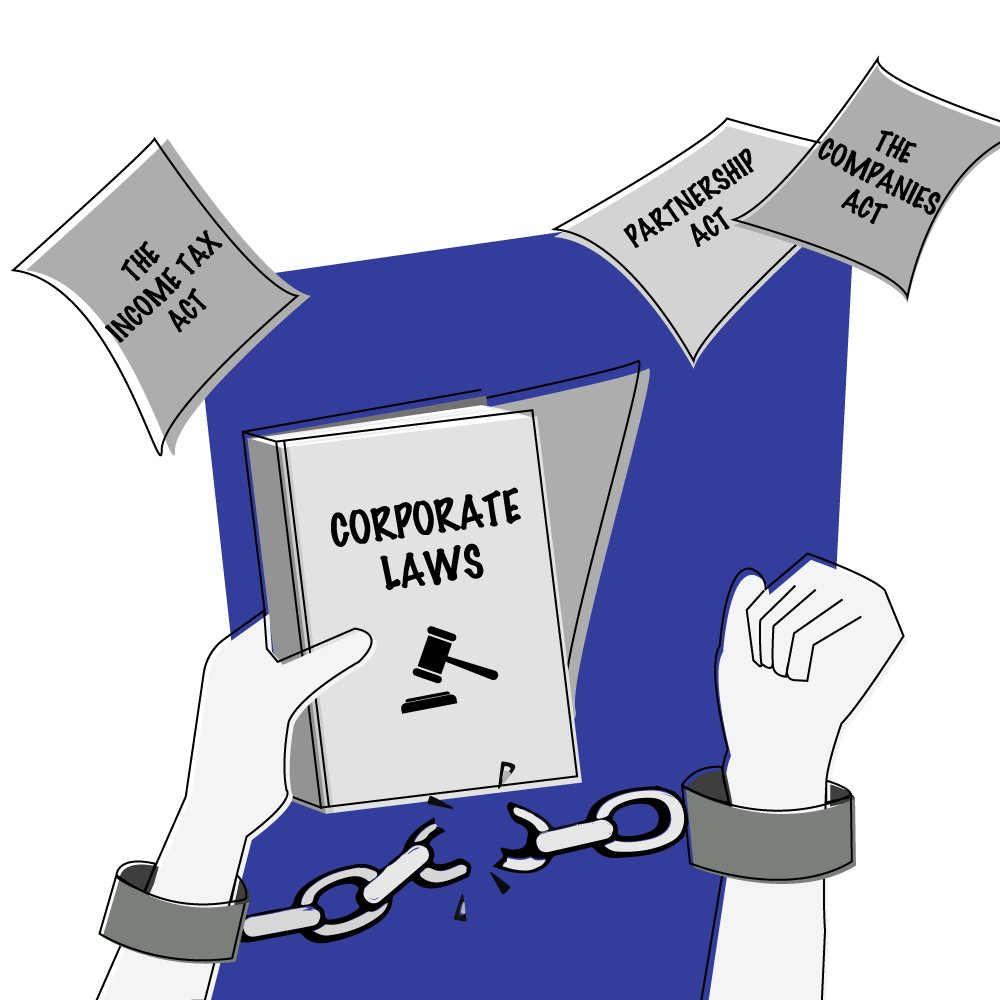The Emancipation of Corporate Laws

Origin
The British East India Company was the first company established in India in 1600. Its charter allowed it to engage in trade in Southeast Asia, mainly in India. After more than 200 years, the Company formally came to be dissolved in India in 1874. The company functioned as a sovereign power under the British Parliament. This was perhaps the earliest company that existed in India.
75 years later, like India, Corporate Laws has evolved (and continues to do so) moulding itself to address challenges arising with changing times and addressing issues affecting stakeholders.
While the term ‘Corporate Law’ is often perceived only to be the Companies Act, there are a entire gamut of laws governing corporates.
Through this article, we trace the journey of some of the most crucial Laws / Acts governing India Inc since independence.
THE COMPANIES ACT (1862, 1866, 1882, 1913, 1956, 2013)
- The Companies Act 1862 (enacted by the Parliament of United Kingdom) governed the functioning of companies in India when the country was under the British rule. The Companies Act 1866 was enacted which consolidated laws relating to incorporation and winding up of trading companies. The Companies Act 1882 replaced the 1866 Act. The Companies Act 1882 was replaced by the Companies Act 1913.
- The Companies Act 1913 was the first Indian company law which governed the registration, incorporation and winding up of companies.
- After independence, the Companies Act 1913 was replaced by the Companies Act 1956 taking cue from the English Companies Act 1948 and based on the Bhaba Committee recommendations. The Act established provisions for registration / incorporation different types of entities – from private and public companies to government companies and those not for profit.
- The most defining feature was to grant company a separate legal entity status, independent of the people who ran / managed it. Consequently, the limited liability concept came into being. The company could acquire property in its own name. people who invested money and ran the company were classified as promoters and directors. Their powers, roles, duties, responsibilities, and liabilities were put in place. Transferability of shares was permitted. The Act detailed all provisions right up to closure or winding up of companies. Exclusive provisions for oppression and mismanagement of shareholders and provisions of dealing with it were prescribed. In 2006, compliance became digital with a whole range of online forms being introduced for filing online. The Ministry of Company / Corporate Affairs created an exclusive website for the same. E-Adjudication was launched for certain offences. From 1956 until 2013, the Act was amended several times to address issues faced by the Indian corporate world.
- The Companies Act 1956 remained in force for long till it was replaced by Companies Act 2013. The Act, which is currently in existence has been very dynamic in amending itself to the changing corporate requirements. From 2013 up until now, several amendments were brought in – mandatory appointment of women directors and independent directors on Boards of certain public companies, introduction of class action suits, categorizing corporates as small private company, One-person company (OPC), Associate company, dormant company etc further categorized the level of compliance and regulated penalties for non-compliance. Initiating corporates (with profit / revenue thresholds) to undertake corporate social responsibility activities (CSR) towards the betterment of the society. Several offences were de-criminalized – those that did not have any element of fraud or affect public interest, were to be e-adjudicated. Penalties/ fines replaced imprisonment. The constitution of the National Company Law Tribunals and appellate tribunals (‘NCLT’ & ‘NCLAT’) replaced the Company Law Board.
THE INCOME TAX ACT (1860, 1886 1918, 1922, 1961)
- The income tax Act 1860 was the first known enactment for tax introduced by the then finance minister of British India. This was done to recover losses sustained due to the Sepoy mutiny. This was replaced by the Income tax Act 1886 under which income was classified under various categories. This was replaced by Income Tax Act 1918 – the first tax law in the independent India. Within 4 years, it was replaced by the Income tax Act 1922 which regulated the income tax structure for the country. There was classification and categorization of income tax authorities and their hierarchy. The Act was in existence until the Income tax Act 1961 replaced the 1922 Act.
- India / Indians are till date governed by the provisions of Income Tax Act 1961. The Act is amended every year by the Union budget where the Finance Bill is approved by both houses of the Parliament.
- The Act governs levy of tax on income or profit earned by individuals and entities (Companies, Firms, LLPs, HUFs etc). It contains thresholds /slabs up to which there is exemption from paying taxes. Thereafter tax is levied. The Act contains provisions which can enable effective tax planning. However, there are stringent provisions for tax evasion and default in paying taxes. The Act itself is divided into direct taxes and indirect taxes.
- The Union budget in 2020 introduced a new tax regime for individuals and HUFs in which they had an option to pay lesser tax rates with effect from FY 2020-21 onwards. The old tax regime is in existence as well.
PARTNERSHIP ACT (1932)
- Prior to 1932, there was no separate law for partnerships in India. Chapter XI of the Indian Contract Act 1872 contained provisions to govern partnership arrangement for Europeans dealing with Indians. As trade and business grew, there was a need to put in place a law that effectively dealt with all aspects of partnership agreements. Hence the Partnership Act 1932 as enacted which remains in force till today.
- Partnerships is not recognized as a body corporate. The partners and the Firm are not distinct from one another. The liability is unlimited.
- The Act deals with all aspects of such arrangements – from requisites of forming a partnership firm, objects and business of the firm, capital or investments, remuneration, profit sharing, management of affairs, liabilities, disputes, changes in partners and regulatory issues.
FOREIGN CONTRIBUTION REGULATION ACT (1976, 2010, 2020)
- The FCRA was first enacted in 1976 to regulate and prohibit acceptance and utilization of foreign (fund) contribution or foreign hospitality (air travel, accommodation etc) by certain individuals, associations or companies for any activities that may prove detrimental to national interest. Typically, “Not for profit” organizations commonly known as NGOs couldn’t freely receive funds or accept hospitality if the purpose of such funds or hospitality was detrimental to interests of the country. Though the Act is related to finance, it has internal and national security implications and hence is directly under the Ministry of Home Affairs.
- The Act was amended in 2010 with the Home ministry making it mandatory for “not for profit” organizations / NGOs to register with the ministry for being eligible to receive foreign contribution. Amendments were proposed in 2020 to cancel registration for those organizations / NGOs for whom the certificate of registration had lapsed. Further amendments were proposed with respect to reporting of utilization of funds / foreign contribution with the objective of ensuring transparency and preventing of misuse. The amendments have been challenged in the Apex court
THE CAPITAL ISSUES (CONTROL) ACT 1947
- This was the first known legislation that controlled issue of capital and contained provisions for regulation of subscription of securities, purchase and sale of securities, advertisement for subscription, prospectus etc. This was necessitated due to limited capital available in the country at that time.
- The Controller of Capital issues was the regulatory authority. The Act was eventually replaced by the SEBI Act in 1992.
SECURITIES CONTRACTS (REGULATION) ACT 1956
- One of the first few legislations enacted to regulate capital markets in India, SCRA enacted to prevent illegal transactions and control and regulate working of stock exchanges in independent India. The Act regulates contracts executed in securities markets.
- The Act has been in existence since with the latest amendment in 2021.
SEBI ACT (1992)
- The Securities and Exchange Board of India (‘SEBI’) was originally established as a non-statutory body which regulated and governed securities markets in India – primarily trading on stock exchanges and related activities. However, in 1992, the Government of India a legislation – SEBI Act which made it an autonomous regulatory body to deal with issues relating to securities /stock markets.
- Over the years, SEBI Act has been regularly amended to address issues of three categories of stakeholders – investors, corporates issuing securities and market intermediaries. Individuals and entities – stockbrokers, broking firms, wealth managers, bankers to an issue, Corporates trading their securities on stock exchanges, portfolio / fund managers, Mutual fuds, Alternate investment funds (AIFs) etc have been brought under the purview of the regulatory authority.
FOREIGN EXCHANGE MANAGEMENT ACT (1999)
- The Act replaced the Foreign Exchange Regulation Act 1973 (FERA).
- The FEMA was enacted essentially to regulate the foreign exchange in India. The Act contains provisions relating to regulation of all foreign exchange transactions in India.
- The Act empowers the Reserve Bank of India (RBI) and the Central government to frame rules and regulations for foreign exchange transactions. They have powers to regulate inflow and outflow of funds to persons resident outside India. FEMA replaced FERA to promote foreign exchange reserves post liberalization of the country. The objective was to facilitate external trade and increase and regulate foreign exchange market in the country.
- The Act has been amended several times and Rules for each aspect are introduced almost every year since its enactment.
PREVENTION OF MONEY LAUNDERING ACT (2002)
- The FEMA paved the way for enactment of the Prevention of Money Laundering Act 2002 (‘PMLA’). The Act puts in place effective systems to prevent money laundering in India. Money laundering is the process of converting money earned through illegal activities into legal currency. Procuring illegal money and investing into shell companies, routing funds through hawala channels, gambling etc are some ways of converting ‘black’ to ‘white’ money.
- The Act was amended in 2005, 2009 and 2013 and 2015. The amendments ranged from granting Enforcement Directorate (ED) powers to confiscate money irrespective of quantity if suspected to be illegal money. The Act grants regulatory authorities the power to confiscate properties procured from illegal money laundered.
COMPETITION ACT (2002)
- This Act replaced the ancient Monopolies & Restrictive Trade Practices Act 1969 whose main objective was to prevent monopolistic practices by a few business entities to ensure there was no concentration of wealth only in few hands. The MRTP Act lost its relevance post liberalization, privatization, and entry of foreign players in India. Indian corporates had to gear up for competition. Monopoly gave way to (healthy) competition. Hence the Act got replaced by the Competition Act in 2002.
- The Competition Act was enacted with the main objective of maintaining a balance between protecting consumer interests while encouraging trade / business in India. Through this Act, the concept of ‘dominance abuse’ was introduced wherein a giant corporate could not take advantage of its size for entering into anti-competitive agreements where smaller businesses would die.
- The first set of amendments have been proposed in 2022 and is under consideration by the Government of India.
LIMITED LIABILITY PARTNERSHIP (2008)
- The Limited Liability Partnership (‘LLP’) is an alternative corporate entity to companies and partnership firms. The best features of private companies (limited liability) and partnership firms (lesser regulatory requirement) were combined to give rise to Limited Liability Partnership (LLP).
- Unlike general partnership, LLP is recognized as a body corporate and has a legal entity distinct from its partners. It is perpetual in existence.
- The Parliament enacted the Limited Liability Act 2008 in December 2008, and the Act came into effect in March 2009. The Act expressly contains provisions relating to formation of LLP, capital, management of affairs, liabilities, disputes, changes in partners and regulatory issues like closure of LLP / winding up.
- The Act has been amended in 2021 & 2022 to address issues of stakeholders.
THE INSOLVENCY & BANKRUPTCY CODE (2016)
- The Insolvency and Bankruptcy Code, 2016 (IBC, 2016) was enacted to provide one stop comprehensive legislation / solution to address financial failure and consequent corporate insolvency.
- The code was enacted with the objective of providing structured solutions to lenders and borrowers alike. For the first time in financial legislation, the creditor was given all importance by vesting them with power / right to initiate insolvency resolution proceeding against a corporate debtor for default in repaying debts. At the same time a moratorium period as envisaged in the Code is provided to the corporate debtor for closure / settlement. A duly appointed Insolvency professional shall be appointed to take over the management of the company to determine the extent and value of claims made by creditors. The idea being not to initiate liquidation only, but to sell bankrupt corporates to other corporates to take over and run it profitably.
- Under the Code, employees and workmen featured in the list of priority after the creditors to enable just and equitable settlement of dues. The Code has been amended to keep pace with the dynamic corporate world and pandemic. It revised thresholds of default and suspended filing of cases during the pandemic. In its 6 years since enactment, the Board has managed to recover almost 2.5 trillion from insolvent companies to its creditors.
GOODS & SERVICE TAX (2017)
- Perceived as one of the most important tax reforms in independent India, Goods and Services Tax (GST) was introduced in the 122nd Constitution Amendment Bill in 2017. It is a game changer with far reaching consequences on the GDP and economy of the country.
- GST is a destination-based tax. It is a uniform tax that is proposed to be levied on all goods and services produced in the country and on all goods and services imported from abroad. It is a comprehensive indirect-tax on manufacture, sale and consumption of goods and services throughout India.
- The objective is to consider India as one market. The Act replaced a number of laws – VAT, Service Tax, CST, Excise, Customs, CENVAT, Entertainment tax, Luxury tax and related taxes primarily to avoid double taxation.
- Ever since its inception, the Act has seen several amendments to keep pace with the financial ecosystem.
India (Inc) shining!
India is a land of opportunities. A handful of companies that existed under the rigid British rule are thriving even today – Tata, Birla, Godrej, Mahindra and TVS group being the torch bearers. These corporates are testimony that the country encourages entrepreneurship and provides opportunity for growth and prosperity. Corporate laws have evolved over decades to keep pace with the changing dynamics while maintaining the balance between economics and public good. At 75, India is on the path of progress and so is India Inc. Jai Hind.

